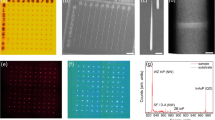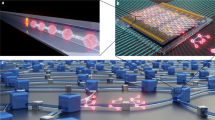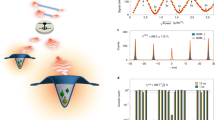Abstract
To make photonic quantum information a reality1,2, a number of extraordinary challenges need to be overcome. One challenge is to achieve large arrays of reproducible ‘entangled’ photon generators, while maintaining compatibility for integration with optical devices and detectors3,4,5. Semiconductor quantum dots are potentially ideal for this as they allow photons to be generated on demand6,7 without relying on probabilistic processes8,9. Nevertheless, most quantum-dot systems are limited by their intrinsic lack of symmetry, which allows only a small number (typically 1 out of 100, or worse) of good dots to be achieved per chip. The recent retraction of Mohan et al.10 seemed to question the very possibility of simultaneously achieving site control and high symmetry. Here, we show that with a new family of (111)-grown pyramidal site-controlled InGaAs1–δNδ quantum dots it is possible to overcome previous hurdles and obtain areas with up to 15% of polarization-entangled photon emitters, with fidelities as high as 0.721 ± 0.043.
This is a preview of subscription content, access via your institution
Access options
Subscribe to this journal
Receive 12 print issues and online access
$209.00 per year
only $17.42 per issue
Buy this article
- Purchase on Springer Link
- Instant access to full article PDF
Prices may be subject to local taxes which are calculated during checkout



Similar content being viewed by others
References
Steane, A. Quantum computing. Rep. Prog. Phys. 61, 117–173 (1998).
Kok, P. et al. Linear optical quantum computing with photonic qubits. Rev. Mod. Phys. 79, 135–174 (2007).
Politi, A., Cryan, M. J., Rarity, J. G., Yu, S. Y. & O'Brien, J. L. Silica-on-silicon waveguide quantum circuits. Science 320, 646–649 (2008).
Politi, A., Matthews, J. C. F., Thompson, M. G. & O'Brien, J. L. Integrated quantum photonics. IEEE J. Sel. Top Quant. Electron. 15, 1673–1684 (2009).
O'Brien, J. L., Pryde, G. J., White, A. G., Ralph, T. C. & Branning, D. Demonstration of an all-optical quantum controlled-NOT gate. Nature 426, 264–267 (2003).
Akopian, N. et al. Entangled photon pairs from semiconductor quantum dots. Phys. Rev. Lett. 96, 130501 (2006).
Stevenson, R. M. et al. A semiconductor source of triggered entangled photon pairs. Nature 439, 179–182 (2006).
Horn, R. et al. Monolithic source of photon pairs. Phys. Rev. Lett. 108, 153605 (2012).
Kwiat, P. G. et al. New high-intensity source of polarization-entangled photon pairs. Phys. Rev. Lett. 75, 4337–4341 (1995).
Mohan, A. et al. Polarization-entangled photons produced with high-symmetry site-controlled quantum dots. Nature Photon. 4, 302–306 (2010).
Benson, O., Santori, C., Pelton, M. & Yamamoto, Y. Regulated and entangled photons from a single quantum dot. Phys. Rev. Lett. 84, 2513–2516 (2000).
Stevenson, R. M. et al. Evolution of entanglement between distinguishable light states. Phys. Rev. Lett. 101, 170501 (2008).
Schliwa, A., Winkelnkemper, M., Lochmann, A., Stock, E. & Bimberg, D. In(Ga)As/GaAs quantum dots grown on a (111) surface as ideal sources of entangled photon pairs. Phys. Rev. B 80, 161307 (2009).
Singh, R. & Bester, G. Nanowire quantum dots as an ideal source of entangled photon pairs. Phys. Rev. Lett. 103, 063601 (2009).
Oberli, D. Y. et al. Coulomb correlations of charged excitons in semiconductor quantum dots. Phys. Rev. B 80, 165312 (2009).
Juska, G., Dimastrodonato, V., Mereni, L. O., Gocalinska, A. & Pelucchi, E. A study of nitrogen incorporation in pyramidal site-controlled quantum dots. Nanoscale Res. Lett. 6, 567 (2011).
Dimastrodonato, V., Mereni, L. O., Juska, G. & Pelucchi, E. Impact of nitrogen incorporation on pseudomorphic site-controlled quantum dots grown by metalorganic vapor phase epitaxy. Appl. Phys. Lett. 97, 072115 (2010).
Young, R. J. et al. Inversion of exciton level splitting in quantum dots. Phys. Rev. B 72, 113305 (2005).
Hudson, A. J. et al. Coherence of an entangled exciton–photon state. Phys. Rev. Lett. 99, 266802 (2007).
Ghali, M., Ohtani, K., Ohno, Y. & Ohno, H. Generation and control of polarization-entangled photons from GaAs island quantum dots by an electric field. Nature Commun. 3, 661 (2012).
Stevenson, R. M. et al. Indistinguishable entangled photons generated by a light-emitting diode. Phys. Rev. Lett. 108, 040503 (2012).
James, D. F. V., Kwiat, P. G., Munro, W. J. & White, A. G. Measurement of qubits. Phys. Rev. A 64, 052312 (2001).
Hill, S. & Wootters, W. K. Entanglement of a pair of quantum bits. Phys. Rev. Lett. 78, 5022–5025 (1997).
Hafenbrak, R. et al. Triggered polarization-entangled photon pairs from a single quantum dot up to 30 K. New J. Phys. 9, 315 (2007).
Peres, A. Separability criterion for density matrices. Phys. Rev. Lett. 77, 1413–1415 (1996).
Trotta, R. et al. Universal recovery of the energy-level degeneracy of bright excitons in InGaAs quantum dots without a structure symmetry. Phys. Rev. Lett. 109, 147401 (2012).
Dimastrodonato, V., Mereni, L. O., Young, R. J. & Pelucchi, E. AlGaAs/GaAs/AlGaAs quantum wells as a sensitive tool for the MOVPE reactor environment. J. Cryst. Growth 312, 3057–3062 (2010).
Pelucchi, E. et al. Decomposition, diffusion, and growth rate anisotropies in self-limited profiles during metalorganic vapor-phase epitaxy of seeded nanostructures. Phys. Rev. B 83, 205409 (2011).
Dimastrodonato, V., Pelucchi, E. & Vvedenski, D. Self-limiting evolution of seeded quantum wires and dots on patterned substrates. Phys. Rev. Lett. 108, 256102 (2012).
Mereni, L. O., Dimastrodonato, V., Young, R. J. & Pelucchi, E. A site-controlled quantum dot system offering both high uniformity and spectral purity. Appl. Phys. Lett. 94, 223121 (2009).
Acknowledgements
This research was partly enabled by the Irish Higher Education Authority Program for Research in Third Level Institutions (2007-2011) via the INSPIRE programme, by Science Foundation Ireland (grants 05/IN.1/I25, 10/IN.1/I3000 and 08/RFP/MTR/1659) and EU FP7 under the Marie Curie Reintegration Grant (PERG07-GA-2010-268300). We thank K. Thomas for his support with the MOVPE system and R.J. Young for his essential help in setting up the correlation setup in the early stages of this project.
Author information
Authors and Affiliations
Contributions
G.J. carried out optical characterization of the samples and data analysis, and wrote the manuscript with E.P. L.O.M. assisted in optical characterization and data analysis. V.D. and A.G. participated in the production of the samples, processing and microscopy characterization. E.P. conceived the study, participated in its design and coordination, and contributed to writing the manuscript. All authors commented on the final manuscript.
Corresponding author
Ethics declarations
Competing interests
The authors declare no competing financial interests.
Supplementary information
Supplementary information
Supplementary information (PDF 891 kb)
Rights and permissions
About this article
Cite this article
Juska, G., Dimastrodonato, V., Mereni, L. et al. Towards quantum-dot arrays of entangled photon emitters. Nature Photon 7, 527–531 (2013). https://doi.org/10.1038/nphoton.2013.128
Received:
Accepted:
Published:
Issue Date:
DOI: https://doi.org/10.1038/nphoton.2013.128
This article is cited by
-
An intuitive protocol for polarization-entanglement restoral of quantum dot photon sources with non-vanishing fine-structure splitting
Scientific Reports (2022)
-
Towards 3D characterisation of site-controlled InGaAs pyramidal QDs at the nanoscale
Journal of Materials Science (2022)
-
High–temperature droplet epitaxy of symmetric GaAs/AlGaAs quantum dots
Scientific Reports (2020)
-
Recent advances in nanowire quantum dot (NWQD) single-photon emitters
Quantum Information Processing (2020)
-
Effects of electrostatic environment on the electrically triggered production of entangled photon pairs from droplet epitaxial quantum dots
Scientific Reports (2019)



